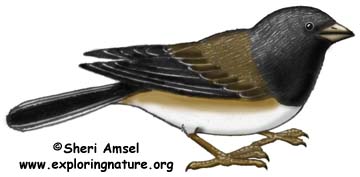

They spend the winter from Southern Canada to Northern Mexico. They breed in the north from western Alaska across Canada to Newfoundland, and south along the mountains in both the west and eastern U.S.
They are found in coniferous forests, mixed forests, fields and thickets.
They are a slate gray sparrow with a white belly and a black head. Their tail feathers have a white border.
They are very common at bird feeders all winter. They are often seen scratching on the ground and in the leaves for food. They travel in flocks.
They eat seeds and insects.
They build an open cup nest of grass and leaves, lined with grass and moss. The female lays 3-5 pale blue eggs with brown spots.
Kingdom: Animalia
Phylum: Chordata
Subphylum: Vetebrata
Class: Aves
Order: Passeriformes
Family: Emberizidae
Genus: Junco
Species: J. hyemalis
When you research information you must cite the reference. Citing for websites is different from citing from books, magazines and periodicals. The style of citing shown here is from the MLA Style Citations (Modern Language Association).
When citing a WEBSITE the general format is as follows.
Author Last Name, First Name(s). "Title: Subtitle of Part of Web Page, if appropriate." Title: Subtitle: Section of Page if appropriate. Sponsoring/Publishing Agency, If Given. Additional significant descriptive information. Date of Electronic Publication or other Date, such as Last Updated. Day Month Year of access < URL >.
Amsel, Sheri. "Junco (Dark-eyed)" Exploring Nature Educational Resource ©2005-2024. December 15, 2024
< http://www.exploringnature.org/db/view/170 >

